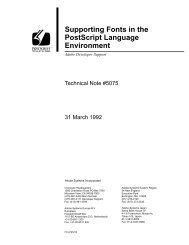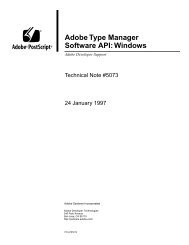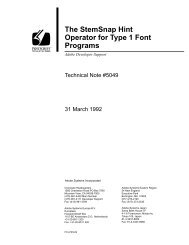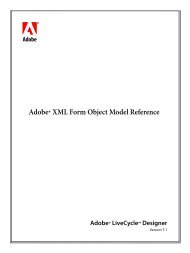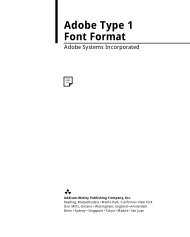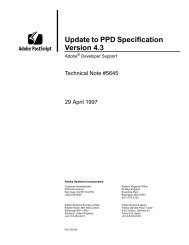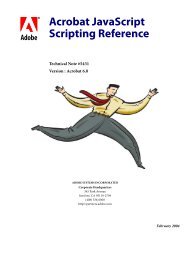Extensible Metadata Platform (XMP) Specification - Adobe Partners
Extensible Metadata Platform (XMP) Specification - Adobe Partners
Extensible Metadata Platform (XMP) Specification - Adobe Partners
You also want an ePaper? Increase the reach of your titles
YUMPU automatically turns print PDFs into web optimized ePapers that Google loves.
3<br />
<strong>XMP</strong> Storage Model<br />
<strong>XMP</strong> Packet Wrapper<br />
●<br />
w means the packet can be updated in place, if there is enough space. The overall length of<br />
the packet must not be changed; padding should be adjusted accordingly. The original<br />
encoding and byte order must be preserved, to avoid breaking text files containing <strong>XMP</strong> or<br />
violating other constraints of the original application.<br />
Scanning Files for <strong>XMP</strong> Packets<br />
This section explains how files can be scanned for <strong>XMP</strong> Packets, and why this should be done<br />
with caution.<br />
Caveats<br />
Knowledge of individual file formats provides the best way for an application to get access to<br />
<strong>XMP</strong> Packets. See Chapter 5, “Embedding <strong>XMP</strong> <strong>Metadata</strong> in Application Files” for detailed<br />
information on how <strong>XMP</strong> data is stored in specific file formats.<br />
Lacking this information, applications can find <strong>XMP</strong> Packets by scanning the file. However,<br />
this should be considered a last resort, especially if it is necessary to modify the data. Without<br />
knowledge of the file format, simply locating packets may not be sufficient. The following are<br />
some possible drawbacks:<br />
● It may not be possible to determine which resource the <strong>XMP</strong> is associated with. If a JPEG<br />
image with <strong>XMP</strong> is placed in a page layout file of an application that is unaware of <strong>XMP</strong>,<br />
that file has one <strong>XMP</strong> Packet that refers to just the image, not the entire layout.<br />
●<br />
●<br />
When there is more than one <strong>XMP</strong> Packet in a file, it may be impossible to determine<br />
which is the “main” <strong>XMP</strong>, and what the overall resource containment hierarchy is in a<br />
compound document.<br />
Some packets could be obsolete. For example, PDF files allow incremental saves.<br />
Therefore, when changes are made to the document, there might be multiple packets, only<br />
one of which reflects the current state of the file.<br />
Scanning Hints<br />
A file should be scanned byte-by-byte until a valid header is found. First, the scanner should<br />
look for a byte pattern that represents the text<br />







